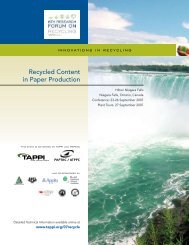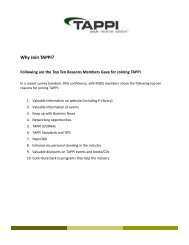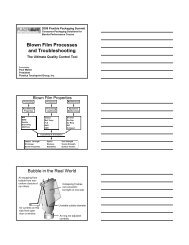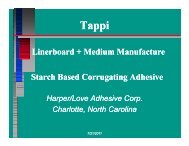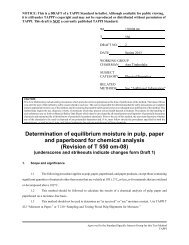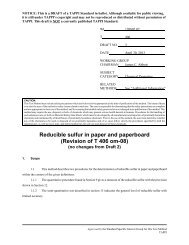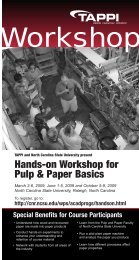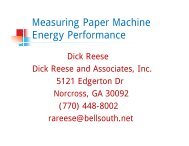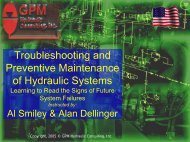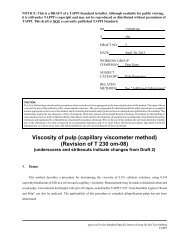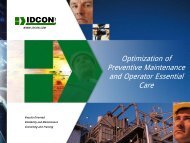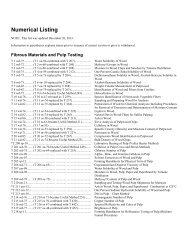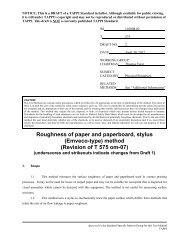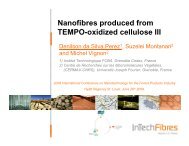The Bleaching of Pulp, 5 Edition By:Peter W. Hart Alan W ... - Tappi
The Bleaching of Pulp, 5 Edition By:Peter W. Hart Alan W ... - Tappi
The Bleaching of Pulp, 5 Edition By:Peter W. Hart Alan W ... - Tappi
Create successful ePaper yourself
Turn your PDF publications into a flip-book with our unique Google optimized e-Paper software.
<strong>The</strong> <strong>Bleaching</strong> <strong>of</strong> <strong>Pulp</strong>, 5 th <strong>Edition</strong><br />
<strong>By</strong>:<strong>Peter</strong> W. <strong>Hart</strong><br />
<strong>Alan</strong> W. Rudie
Copyright© 2012 by<br />
TAPPI PRESS<br />
15 Technology Parkway South<br />
Norcross, GA 30092 U.S.A.<br />
www.tappi.org<br />
All rights reserved<br />
<strong>The</strong> Association assumes no liability or responsibility in connection with the use <strong>of</strong> this<br />
information or data, including, but not limited to, any liability or responsibility under patent,<br />
copyright, or trade secret laws. <strong>The</strong> user is responsible for determining that this document is the<br />
most recent edition published.<br />
To obtain copyright permission to photocopy pages from this publication for internal or personal<br />
use, contact Copyright Clearance Center, Inc. (CCC) via their website at www.copyright.com. If<br />
you have questions about the copyright permission request process, please contact CCC by phone<br />
at +1-978-750-8400.<br />
To obtain copyright permission to use excerpts from this publication in another published work,<br />
send your specific request in writing to TAPPI PRESS, 15 Technology Parkway South, Norcross,<br />
GA 30092 or by fax to +1-770-446-6947.<br />
ISBN: 978-1-59510-207-2<br />
TAPPI PRESS Order Number: 0101R331<br />
Printed in the United States <strong>of</strong> America
Table <strong>of</strong> Contents<br />
i. Authors List<br />
ii. Table <strong>of</strong> Contents<br />
1. Introduction<br />
1.1 Previous <strong>Pulp</strong> <strong>Bleaching</strong> Books<br />
1.2. Current <strong>Pulp</strong> <strong>Bleaching</strong> Book<br />
1.3. Organization <strong>of</strong> the Current Book<br />
1.4. References Cited<br />
2. Oxygen Delignification<br />
2.1. Introduction<br />
2.1.1. Comparison <strong>of</strong> Oxygen to Other <strong>Bleaching</strong> Agents<br />
2.1.2. Advantages and Disadvantages <strong>of</strong> Oxygen Delignification<br />
2.2. Chemistry <strong>of</strong> Oxygen Delignification<br />
2.2.1. Lignin Reactions<br />
2.2.2. Carbohydrate Reactions<br />
2.3. Kinetics <strong>of</strong> Oxygen Delignification<br />
2.3.1. Kinetic Rate Equations<br />
2.3.1.1. Initial Kappa Number<br />
2.3.1.2. Alkali Charge, Temperature and Oxygen Partial Pressure<br />
2.3.1.3. Rate Equations<br />
2.3.2. Carbohydrate Selectivity<br />
2.4. Mass Transfer Effects<br />
2.4.1. Oxygen Solubility<br />
2.4.2. Liquid Phase Mass Transfer Coefficients for Mixers<br />
2.4.3. Mass Transfer Coefficient in Retention Towers<br />
2.5. Carry-over <strong>of</strong> Dissolved Solids<br />
2.6. Control <strong>of</strong> Transition Metals<br />
2.6.1. Addition <strong>of</strong> Magnesium Ion<br />
2.6.2. Use <strong>of</strong> Chelating Agents<br />
2.7. Commercial Medium Consistency Oxygen Delignification Systems<br />
2.7.1. One-Stage Design<br />
2.7.2. Two-Stage Designs<br />
2.7.2.1. OxyTracTM Systems<br />
2.7.2.2. GL&V System<br />
2.7.3. Reductions in Kappa Number<br />
2.8. <strong>Pulp</strong> Quality
2.9. Emission <strong>of</strong> Volatile Organic Compounds<br />
2.10. Acknowledgments<br />
2.11. References Cited<br />
3. Chlorine Dioxide as a Delignifying Agent<br />
3.1. Introduction<br />
3.2. Delignification Chemistry<br />
3.3. Standard D 0 Stage Conditions<br />
3.3.1. Furnish and Effect <strong>of</strong> Cooking Conditions<br />
3.3.2. Chemical Charge<br />
3.3.3. pH<br />
3.3.4. Time and Temperature<br />
3.3.5. Consistency<br />
3.3.6. Carryover from Brownstock Washing<br />
3.4. <strong>Pulp</strong> Quality - Viscosity and Strength<br />
3.5. Summary<br />
3.6. Acknowledgements<br />
3.7. References Cited<br />
4. Extraction and Oxidative Extraction<br />
4.1. Introduction<br />
4.2. General Overview <strong>of</strong> Alkaline Extraction<br />
4.3. Extraction Delignification Process Variables for ECF Sequences<br />
4.3.1. Chlorine Dioxide Delignification (D 0 ) Chemical Charge<br />
4.3.2. Caustic Charge and pH<br />
4.3.3. Oxygen and Peroxide Reinforcement<br />
4.3.4. Reaction Temperature<br />
4.3.5. Retention Time<br />
4.3.6. Consistency<br />
4.3.7. Carryover<br />
4.4. Extraction Delignification for TCF Sequences<br />
4.5. <strong>Pulp</strong> Quality<br />
4.6. Alternative Alkali Sources for Extraction<br />
4.7. Second Extraction Stage<br />
4.8. References Cited<br />
5. <strong>The</strong> Hot Acid Stage for Hexenuronic Acid Removal<br />
5.1. Hexenuronic Acids<br />
5.1.1. Introduction<br />
5.1.2. Formation and degradation during alkaline cooking<br />
5.1.2.1. Effect <strong>of</strong> wood 4-O-methyl-α-D-glucuronic acid content
5.1.2.2. Effect <strong>of</strong> cooking technology<br />
5.1.2.3. Effect <strong>of</strong> cooking conditions<br />
5.1.2.4. Effect <strong>of</strong> delignification degree<br />
5.1.3. Quantification in alkaline pulps<br />
5.1.4. Impact on oxygen delignification<br />
5.2. <strong>The</strong> Hot Acid Stage (A-stage)<br />
5.2.1. Introduction<br />
5.2.2. Chemistry<br />
5.2.3. Kinetics<br />
5.2.4. Effect <strong>of</strong> reaction time/temperature and pH<br />
5.2.5. Effect on pulp constituents, yield and viscosity<br />
5.2.7. Effect on pulp strength properties<br />
5.2.8. Effect on pulp brightness stability<br />
5.2.9. Effect on effluent load and treatability<br />
5.2.10. Alternate methods for HexA removal<br />
5.3. Hot acid stage technologies<br />
5.3.1. Standalone A-stage<br />
5.3.2. A/D technology<br />
5.3.3. D/A technology<br />
5.3.4. A/D versus D/A technologies<br />
5.4. Industrial bleaching sequences with an A-stage<br />
5.5. Acknowledgements<br />
5.6. References Cited<br />
6. <strong>The</strong> Use <strong>of</strong> Enzymes in <strong>Pulp</strong> <strong>Bleaching</strong><br />
6.1. <strong>The</strong> Use <strong>of</strong> Enzymes in <strong>Pulp</strong> <strong>Bleaching</strong><br />
6.1.1. Introduction<br />
6.1.2. Enzyme types<br />
6.1.3. Enzyme impacts upon mill operations and pulp yield<br />
6.2. Application Criteria<br />
6.2.1. Introduction<br />
6.2.2. Temperature control<br />
6.2.3. pH Control<br />
6.2.3.1. General concerns<br />
6.2.3.2. Use <strong>of</strong> mineral acids for pH control<br />
6.2.3.3. Determining Acid demand<br />
6.2.3.4. pH drift<br />
6.2.3.5. Use <strong>of</strong> carbon dioxide for pH control<br />
6.2.4. Mixing<br />
6.2.4.1. Mixing Challenges<br />
6.2.4.2. Determining mixing efficiency<br />
6.2.4.3. Demonstration <strong>of</strong> mixing using showers on a washer<br />
6.2.4.3. Mixing summary.<br />
6.2.5. Retention time<br />
6.2.5.1. Impact <strong>of</strong> time
6.2.5.2. Channeling<br />
6.2.6. Application summary.<br />
6.3. Converting Enzyme Performance to Benefits<br />
6.3.1. Mill specific options<br />
6.3.2. Change in fiber bleachability<br />
6.3.3. Yield considerations<br />
6.3.4. Economics<br />
6.4. References Cited<br />
7. Mineral Scale Management<br />
7.1 Introduction<br />
7.1.1 Trace Metals in Wood and <strong>Pulp</strong>ing<br />
7.1.2 Generalized behavior <strong>of</strong> metals<br />
7.1.3 Calcium<br />
7.1.4 Oxalic Acid<br />
7.1.5 Barium<br />
7.2 Chemical Fundamentals<br />
7.2.1 Acid and Base Equilibria<br />
7.2.2 Precipitation Equilibria (Solubility Product)<br />
7.2.3 Ion Activity<br />
7.2.4 Supersaturation<br />
7.3 Case Studies:<br />
7.3.1 Digester (White Liquor) Chip Strainer<br />
7.3.2 Lime Scale on Extraction stage washer<br />
7.3.3 Barite scale in D 0<br />
7.3.4 Oxalate scale on D 0 washer<br />
7.3.5 Oxalate scale in an Extraction stage mixer<br />
7.3.6 Barite scale in D 0<br />
7.4 Calculating the Trace Metals Partition in a Mill Environment<br />
7.4.1 Ion Exchange using Solution State Equilibrium theory<br />
7.4.2 Donnan <strong>The</strong>ory<br />
7.4.3 Selectivity Coefficient Approach<br />
7.4.4 Fundamental Approaches<br />
7.4.5 Calculating soluble calcium<br />
7.5 Summary<br />
7.6 References Cited<br />
8. Chlorine Dioxide as a Brightening Agent<br />
8.1. Introduction<br />
8.2. D Stage Conditions<br />
8.2.1. Chemical Charge<br />
8.2.2. Residual chlorine dioxide<br />
8.2.3. pH<br />
8.2.4. Time and Temperature<br />
8.2.5. D Stage Consistency
8.2.6. Carryover to D Stages<br />
8.3. Summary<br />
8.4. Acknowledgements<br />
8.5. References Cited<br />
9. Ozone Delignification<br />
9.1. Introduction<br />
9.2. Fundamental Aspects <strong>of</strong> Ozone <strong>Bleaching</strong><br />
9.2.1 Ozone reactions with lignin and cellulose<br />
9.2.2 Expression <strong>of</strong> ozone reactivity, effectiveness and selectivity<br />
9.3. Process Conditions<br />
9.3.1 Mass transfer <strong>of</strong> ozone to liquid phase<br />
9.3.2 <strong>Pulp</strong> consistency<br />
9.3.3 Ozone Charge<br />
9.3.4 Effect <strong>of</strong> pH<br />
9.3.5 Time<br />
9.3.6 Temperature<br />
9.3.7 Additives<br />
9.3.8 Metal ions<br />
9.3.9 Dissolved organic matter<br />
9.3.10 <strong>Pulp</strong> processing before ozone stage.<br />
9.3.11 Alkaline extraction after ozone stages<br />
9.4. Role <strong>of</strong> Ozone in a <strong>Bleaching</strong> Sequence<br />
9.4.1 Ozone delignification as a replacement for chlorination<br />
9.4.2 Placement <strong>of</strong> ozone in a bleaching sequence<br />
9.5. Process Equipment<br />
9.5.1 High-Consistency Ozonation<br />
9.5.2 Medium-Consistency Ozonation<br />
9.5.3 Low-Consistency Ozonation<br />
9.5.4 Materials <strong>of</strong> Construction<br />
9.6. Environmental Considerations<br />
9.7. References Cited<br />
10. Peroxide <strong>Bleaching</strong><br />
10.1. Introduction<br />
10.2. General Overview <strong>of</strong> Peroxide <strong>Bleaching</strong><br />
10.3. Factors Affecting Peroxide <strong>Bleaching</strong><br />
10.3.1. Peroxide Charge<br />
10.3.2. Caustic Charge and pH<br />
10.3.4. Consistency<br />
10.3.5. Mitigation <strong>of</strong> Peroxide Decomposition by Transitional Metal Ions<br />
10.3.6. Washer Carryover<br />
10.4. <strong>Pulp</strong> Viscosity, Strength and Particle Removal
10.5. Brightness Stability<br />
10.6. Peroxide in <strong>Bleaching</strong> Sequences<br />
10.6.1. ECF<br />
10.6.2. ECF-Light<br />
10.6.3. TCF<br />
10.6.4 Post <strong>Bleaching</strong> in High Density Storage<br />
10.7. Peroxide Catalysts and Activators<br />
10.8. Peroxy Acids<br />
10.9. Summary<br />
10.10. References Cited<br />
11. Dirt and Shive Management<br />
11.1. Introduction<br />
11.1.1. Types <strong>of</strong> Dirt<br />
11.2. Dirt and Shive Reduction – Case Studies<br />
11.2.1. Slotted Screens<br />
11.2.2. Oxygen Delignification<br />
11.2.3. Post <strong>Bleaching</strong> Screens<br />
11.3. Dirt and Shive Measurement<br />
11.3.1. Shives and Large Particles<br />
11.3.2. Dirt measurement<br />
11.4. <strong>Bleaching</strong> <strong>of</strong> Dirt and Shives<br />
11.4.1. Oxygen<br />
11.4.2. Chlorine Dioxide<br />
11.4.3. Mixing<br />
11.4.4. Alkaline Extraction<br />
11.4.5. Peroxide<br />
11.4.6. Ozone<br />
11.4.7. Enzymes<br />
11.5. Summary<br />
11.6. References Cited<br />
12. Multi-Stage Bleach Plant Modeling and Optimization<br />
12.1. Introduction<br />
12.2. General Overview <strong>of</strong> Bleach Sequence<br />
12.3. Modeling <strong>of</strong> Bleach Sequences<br />
12.4. Kinetic Modeling <strong>of</strong> Bleach Sequences<br />
12.4.1. Modeling Chlorine Dioxide Delignification (D 0 )<br />
12.4.2. Modeling Caustic Extraction Delignification with Oxidant<br />
Reinforcement<br />
12.4.3. Modeling Chlorine Dioxide Brightening (D 1 and D 2 )<br />
12.4.4. Modeling Dispersion in <strong>Bleaching</strong> Towers
12.4.5. Modeling Bleach Effluent Characteristics<br />
12.5. Steady-State Modeling <strong>of</strong> Bleach Sequences<br />
12.5.1. Steady-State Models for D 1 and D 2<br />
12.5.2. Steady-State Models for D 0 and Extraction ((EO), (EP) or (EOP))<br />
12.6. Optimization <strong>of</strong> Bleach Sequences Based on Models<br />
12.6.1. Optimum Chlorine Dioxide Load Sharing between D 1 and D 2<br />
12.6.2. Optimum Chlorine Dioxide Load Sharing between Delignification<br />
and Brightening<br />
12.6.2.1. S<strong>of</strong>twood <strong>Pulp</strong><br />
12.6.2.2. Hardwood <strong>Pulp</strong><br />
12.6.3. Optimization Involving Oxidative Extraction Variables and Chlorine<br />
Dioxide Usage<br />
12.6.3.1. S<strong>of</strong>twood <strong>Pulp</strong><br />
12.6.3.2. Hardwood <strong>Pulp</strong><br />
12.7. Impacts <strong>of</strong> Washer Carry-Over<br />
12.8. Impact <strong>of</strong> Kraft <strong>Pulp</strong>ing Conditions on <strong>Bleaching</strong><br />
12.9. Other Factors Impacting <strong>Bleaching</strong> Optimization<br />
12.10. Summary<br />
12.11. References Cited<br />
13. Metso Paper – Chemical and Mechanical <strong>Pulp</strong> <strong>Bleaching</strong><br />
Solutions<br />
13.1. Introduction<br />
13.2. <strong>Pulp</strong> Production<br />
13.2.1. Wood/Chip Handling<br />
13.2.2. Cooking<br />
13.2.3. Deknotting, Screening and Washing<br />
13.3. Bleach Plant Design<br />
13.3.1. Pumping<br />
13.3.2. Mixing<br />
13.3.3. Reaction<br />
13.3.4. Reactor/ Tower Tank Equipment<br />
13.3.4.1. Reactor Inlet Distribution<br />
13.3.4.2. Tower Dischargers<br />
13.3.4.3. Reactor Blow Tank or Blow Tube<br />
13.3.5. Reactor / Tower / Stock Tank Design<br />
13.3.5.1. Pressurized Towers<br />
13.3.5.2. Atmospheric Towers<br />
13.3.6. Washing<br />
13.3.6.1. TwinRoll Evolution Wash Press<br />
13.3.6.2. <strong>The</strong> W-Press<br />
13.4. Oxygen Delignification<br />
13.5. Chlorine Dioxide <strong>Bleaching</strong>
13.6. Extraction<br />
13.7. Peroxide <strong>Bleaching</strong><br />
13.7.1. (PO)-bleaching<br />
13.7.2. P-<strong>Bleaching</strong><br />
13.8. Ozone <strong>Bleaching</strong> - <strong>The</strong> ZeTrac<br />
13.9. Other <strong>Bleaching</strong> Methods<br />
13.9.1. Q-stage<br />
13.9.2. Peracid <strong>Bleaching</strong><br />
13.9.2. Enzyme Treatment<br />
13.10. <strong>Bleaching</strong> Sequences<br />
13.10.1. ECF Light <strong>Bleaching</strong><br />
13.10.2. TCF <strong>Bleaching</strong><br />
13.11. Bleach Plant Closure<br />
13.12. Mechanical <strong>Pulp</strong> <strong>Bleaching</strong><br />
13.12.1. Introduction<br />
13.12.2. Bleach Plant Equipment<br />
13.12.2.1. TwinRoll TM Press<br />
13.12.2.2. TwinWire Press<br />
13.12.2.3. Rotomixer TM<br />
13.12.3. Overall System Design<br />
14. Andritz <strong>Bleaching</strong> Technology for Chemical and<br />
Mechanical <strong>Pulp</strong>s<br />
14.1. Chemical pulp bleaching<br />
14.1.1. Background<br />
14.1.2. Chemical <strong>Pulp</strong> <strong>Bleaching</strong> sequences<br />
14.1.3. MC equipment in bleaching<br />
14.1.3.1. Andritz MC pump<br />
14.1.3.2. AC chemical mixer<br />
14.1.3.3. AZ Chemical mixer<br />
14.1.3.4. Other MC equipment with mixing<br />
14.1.3.5. ARF and ARD Flow Discharger<br />
14.1.3.6. ATS-MC and ATS-LC top scrapers<br />
14.1.3.7. ADS Discharge Scraper<br />
14.1.4. Reactor and tower technology<br />
14.1.4.1. Pressurized towers<br />
14.1.4.2. Atmospheric towers<br />
14.1.5. Washing technology in bleaching<br />
14.1.5.1. GasFree filter (GF filter)<br />
14.1.5.2. Drum Displacer washer (DD washer)<br />
14.1.5.3. Andritz Wash Press (AWP, AWP-D)<br />
14.1.6. <strong>Bleaching</strong> stage technology<br />
14.1.6.1. Alkaline bleaching stages<br />
14.1.6.2. Two-stage oxygen
14.1.6.3. Oxygen stage and screenroom<br />
14.1.6.4. Acidic bleaching stages<br />
14.1.6.5. Hexenuronic acid hydrolysis<br />
14.2. Mechanical <strong>Pulp</strong> <strong>Bleaching</strong> and Washing<br />
14.2.1. Introduction<br />
14.2.2. Main components<br />
14.2.3. Dewatering <strong>of</strong> mechanical pulp<br />
14.2.3.1. Dewatering and washing prior to the HC- bleach tower<br />
14.2.3.2. Washing after bleaching<br />
14.2.4. Dewatering equipment<br />
14.2.4.1. Comparison <strong>of</strong> dewatering machines<br />
14.2.4.2. Twin Wire Press<br />
14.2.4.3. Screw press<br />
14.2.5. High-Consistency Mixer<br />
14.2.6. Bleach towers<br />
14.2.6.1. HC-Tower discharge system<br />
14.2.6.2. MC/LC-Tower discharge system<br />
14.3. References Cited<br />
15. GL&V Modern Bleach Plant Design and Operation<br />
15.1. INTRODUCTION<br />
15.2. PROCESS SELECTION<br />
15.3. Modern ECF Bleach Plant Design and Equipment<br />
15.3.1. Bleach Plant Process Design<br />
15.3.2. DUALOX Oxygen Delignification<br />
15.3.2.1. Introduction and Chemistry<br />
15.3.2.2. Physical Arrangement<br />
15.3.3. <strong>Pulp</strong> Washing<br />
15.3.4. Pumping and Mixing<br />
15.3.4.1. Medium Consistency pumping<br />
15.3.4.2. Chemical Mixing<br />
15.3.5. <strong>Bleaching</strong><br />
15.3.5.1. Introduction and Chemistry<br />
15.3.5.2. First Stage Chlorine Dioxide <strong>Bleaching</strong><br />
15.3.5.3. Second Stage Oxidative Extraction<br />
15.3.5.4. Wash Water and Filtrate Recirculation<br />
15.3.6. Plant Design<br />
15.4. Alternative <strong>Bleaching</strong> Sequences<br />
15.5. References Cited
16. Instrumentation - <strong>Bleaching</strong> sensors and control<br />
16.1. Introduction<br />
16.2. Sensors<br />
16.2.1. Flow meters<br />
16.2.1.1. Magnetic Flow Meter<br />
16.2.1.2. Vortex Flow Meter<br />
16.2.1.3. Differential pressure type meters<br />
16.2.1.4. Coriolis Mass Flow and Density Meters<br />
16.2.1.5. <strong>The</strong>rmal Type Flow Meters<br />
16.2.1.6. Doppler Flow Meter<br />
16.2.1.7. Time <strong>of</strong> Flight Ultrasonic flow meter<br />
16.2.1.8. Sonar Flow Meter<br />
16.2.1.9. Turbine Flow Meters<br />
16.2.1.10. Positive Displacement Flow Meter<br />
16.2.2. Consistency meters<br />
16.2.2.1. Blade Type<br />
16.2.2.2. Rotary Type<br />
16.2.2.3. Optical Consistency Meter<br />
16.2.2.4. Microwave Consistency Meter<br />
16.2.3. Brightness meters<br />
16.2.3.1. Lab Brightness Meters<br />
16.2.3.2.On-line Brightness Analyzers<br />
16.2.3.3.In-line Brightness meters<br />
16.2.4. Residual chemical meters<br />
16.2.4.1. Polarographic meter<br />
16.2.4.2. Oxidation-Reduction Potential Meter<br />
16.2.5. Colorimeters<br />
16.2.6. Spectrometers<br />
16.2.7. pH meters<br />
16.2.8. Kappa analyzers<br />
16.2.9. Level sensors<br />
16.2.9.1. Differential pressure meter<br />
16.2.9.2. Radar and microwave level sensors<br />
16.2.9.3. Ultrasonic and sonic level meters<br />
16.2.9.4. Radio Frequency level meters<br />
16.2.10. Temperature sensors<br />
16.2.10.1. <strong>The</strong>rmocouples<br />
16.2.10.2. <strong>The</strong>rmistors<br />
16.2.10.3. Resistance Temperature Detectors<br />
16.2.10.4. Temperature Probes<br />
16.2.11. Conductivity sensors<br />
16.3. Control strategies common to most bleaching stages<br />
16.3.1. Consistency control<br />
16.3.2. Fibre mass flow rate measurement and control<br />
16.3.3. Chemical % applied control<br />
16.3.4. Temperature control
16.3.5. pH control<br />
16.3.6. Level control<br />
16.3.7. Vacuum Washer controls<br />
16.3.7.1. Shower Flow Controller(s)<br />
16.3.7.2. Vat Level Controller<br />
16.3.7.3. Drum Speed Controller-Dilution<br />
16.3.7.4. Drum Speed Controller-Defoamer<br />
16.3.7.5. Seal Tank Foam Probe<br />
16.4. Control strategies by stage<br />
16.4.1. D 0 stage ClO 2 control<br />
16.4.2. E stage caustic control<br />
16.4.3. D 1 and D 2 stage control<br />
16.5. Bringing it all together<br />
16.6. References Cited<br />
17. Brightening <strong>of</strong> High-yield <strong>Pulp</strong>s<br />
17.1 Introduction to Brightening Technology<br />
17.2. Principles <strong>of</strong> Hydrogen Peroxide Brightening<br />
17.2.1. Wood Chemistry<br />
17.2.2. Alkalinity<br />
17.2.3. Sodium Silicate<br />
17.2.4. Organic Stabilizers<br />
17.2.5. Chelant Pretreatment<br />
17.2.6. Magnesium Sulphate<br />
17.2.7. Post-Brightening Neutralization<br />
17.2.8. Temperature/Retention Time<br />
17.2.9. Consistency Effects<br />
17.2.10. Wood Species Effects<br />
17.2.11. <strong>Pulp</strong> Type Effects<br />
17.3. Mechanics <strong>of</strong> Peroxide Brightening<br />
17.3.1. Single Tower<br />
17.3.1.1. Single Tower Variations<br />
17.3.1.2. Other Single Stage Tower Considerations<br />
17.3.2. Two-Stage Sequences<br />
17.3.3. Interstage Treatment<br />
17.3.4. Post-Brightening Washing<br />
17.3.5. Refiner Brightening<br />
17.3.6. Steep or Flash Drier Brightening<br />
17.3.7. Multi-Stage Sequences<br />
17.4. Alkaline Peroxide for Strength Improvement and Energy<br />
Reduction<br />
17.4.1. Primary Line Treatment<br />
17.4.2. Rejects Treatment<br />
17.5. Principles <strong>of</strong> Sodium Hydrosulfite Brightening<br />
17.5.1. Wood Chemistry<br />
17.5.2. pH Effects<br />
17.5.3. Temperature/Retention Time
17.5.4. Consistency Effects<br />
17.5.5. Effects <strong>of</strong> Sequestrants<br />
17.5.6. Effect <strong>of</strong> Wood Species<br />
17.6. Mechanics <strong>of</strong> Sodium Hydrosulfite Brightening<br />
17.7. Storage / Handling <strong>of</strong> Chemicals<br />
17.7.1. Hydrogen Peroxide<br />
17.7.2. Sodium Hydrosulfite<br />
17.8. Additional Oxidizing/Reducing Agents<br />
17.9. Conclusions<br />
17.10. References Cited<br />
18. Brightness: Basic Principles and Measurement<br />
18.1. Introduction<br />
18.2. History<br />
18.2.1 Original Design<br />
18.2.2 A newer Instrument design<br />
18.3. Whiteness<br />
18.4. Optical additives<br />
18.4.1 Dyes and Fluorescent whitening agents<br />
18.4.2 Fillers and Pigments<br />
18.5. Brightness in the Industry<br />
18.5.1 Brightness in <strong>Bleaching</strong><br />
18.5.2 Brightness in the Product<br />
18.6 Measurement<br />
18.6.1 Calibration<br />
18.6.2 Measurement<br />
18.7 Summary<br />
18.8. References Cited<br />
19. <strong>Pulp</strong> <strong>Bleaching</strong> and the Environment<br />
19.1. Overview - Environmental Aspects <strong>of</strong> <strong>Pulp</strong> <strong>Bleaching</strong><br />
19.2. Effluent Characteristics and Composition<br />
19.2.1. Effluent Characteristics<br />
19.2.2. Monitoring and Testing <strong>of</strong> Bleach Plant and Mill Effluents<br />
19.2.3. Environmental Performance at Today’s Bleached Mills<br />
19.3. Assessing the Potential Effects <strong>of</strong> <strong>Pulp</strong>ing and <strong>Bleaching</strong><br />
Operations on the Aquatic Environment<br />
19.3.1. Introduction<br />
19.3.1.1 Lack <strong>of</strong> uniqueness <strong>of</strong> effluent biological responses from mills<br />
practicing pulp bleaching<br />
19.3.1.2 Lack <strong>of</strong> relevance <strong>of</strong> biomarker responses to measureable<br />
environmental effects<br />
19.3.1.3 Inconclusive results <strong>of</strong> limited field studies <strong>of</strong> pulp mill effluent
effects<br />
19.3.2. Interpreting important findings from recent studies<br />
19.3.2.1 Study structure<br />
19.3.2.2 Judging the relevance <strong>of</strong> literature reports<br />
19.3.2.3 Studies addressing fish reproduction<br />
19.3.2.4 Mosquit<strong>of</strong>ish studies<br />
19.3.3. Long-term field assessments <strong>of</strong> pulp mill effluent effects<br />
19.3.3.1 Background<br />
19.3.3.2 Canadian environmental effects monitoring program<br />
19.3.3.3 US long-term receiving water study<br />
19.3.4. Conclusion<br />
19.4. Bleach Plant Air Emissions<br />
19.4.1. Introduction<br />
19.4.2. Oxygen Delignification Emissions<br />
19.4.3. Bleach Plant Emissions<br />
19.4.3.1 Chlorine and Chlorine Dioxide Emissions<br />
19.4.3.2 Ozone emissions<br />
19.4.3.3. Organic Compound Emissions<br />
19.4.3.4 Other organic compounds<br />
19.4.4. Control <strong>of</strong> Chlorine and Chlorine Dioxide from Bleach Plants<br />
19.4.4.1 Scrubbing media used in chlorine and chlorine dioxide scrubbers<br />
19.4.4.2 Scrubber process control parameters and monitoring<br />
19.5. Environmental Regulations<br />
19.5.1. Introduction<br />
19.5.2. Canadian Regulations<br />
19.5.2.1. Fisheries act<br />
19.5.2.2 Canadian Environmental Protection Act (CEPA)<br />
19.5.3. United States Regulations – Water Discharges<br />
19.5.3.1 Introduction<br />
19.5.3.2 Water quality-based permit limits<br />
19.5.3.3 Current technology-based limitations guidelines for wastewaters<br />
19.5.3.4. Effects Monitoring<br />
19.5.4. United States Regulations – Air Emissions<br />
19.5.4.1 Introduction<br />
19.5.4.2. Technology-based regulations for emissions to air from<br />
bleached pulp mills<br />
19.5.5. Other Regulations That Apply to Bleach Plants<br />
19.5.5.1 Chlorine Dioxide Generating Systems<br />
19.5.5.2 Annual chemical release reporting requirements<br />
19.5.5.3 Risk Management Plans<br />
19.6. List <strong>of</strong> Abbreviations and Acronyms<br />
19.7. References Cited<br />
20. Safe Storage and Handling <strong>of</strong> <strong>Bleaching</strong> Chemicals
20.1 Introduction<br />
20.2 Chlorine Dioxide (ClO 2 )<br />
20.2.1 Definition and Properties<br />
20.2.2 Health and Safety Hazards<br />
20.2.2.1 Major Hazards<br />
20.2.2.2 Eye<br />
20.2.2.3 Skin<br />
20.2.2.4 Inhalation<br />
20.2.2.5 Ingestion<br />
20.2.2.6 Chronic Effects<br />
20.2.2.7 Fire and Explosion<br />
20.2.2.8 Other Hazards<br />
20.2.3 Warning Properties<br />
20.2.4 Personal Protective Equipment<br />
20.2.5 Safety Equipment<br />
20.2.6 Handling Spills and Leaks<br />
20.2.7 Housekeeping and Routine Maintenance<br />
20.2.8 Unloading Considerations<br />
20.2.9 Design Considerations for Storage and Handling<br />
20.2.9.1 General<br />
20.2.9.2 Location<br />
20.2.9.3 Storage Tanks<br />
20.2.9.4 Containment<br />
20.2.9.5 Lubricants<br />
20.2.9.6 Chlorine Dioxide Generators<br />
20.2.9.7 Materials <strong>of</strong> Construction<br />
20.3 Hydrogen Peroxide (H 2 O 2 )<br />
20.3.1 Definition and Properties<br />
20.3.2 Health and Safety Hazards<br />
20.3.2.1 Major Hazards<br />
20.3.2.2 Eye<br />
20.3.2.3 Skin<br />
20.3.2.4 Inhalation<br />
20.3.2.5 Ingestion<br />
20.3.2.6 Chronic Effects<br />
20.3.2.7 Fire and Explosion<br />
20.3.2.8 Other Hazards<br />
20.3.2.9 Hazard Classifications<br />
20.3.3 Warning Properties<br />
20.3.4 Personal Protective Equipment<br />
20.3.5 Safety Equipment<br />
20.3.6 Handling Spills and Leaks<br />
20.3.7 Housekeeping and Routine Maintenance<br />
20.3.8 Unloading Considerations<br />
20.3.9 Design Considerations for Storage and Handling<br />
20.3.9.1 General<br />
20.3.9.2 Location<br />
20.3.9.3 Storage Tanks<br />
20.3.9.4 Insulation<br />
20.3.9.5 Containment
20.3.9.6 Pumps<br />
20.3.9.7 Lubricants<br />
20.3.9.8 Piping<br />
20.3.9.9 Pressure Relief Valves<br />
20.3.9.10 Materials <strong>of</strong> Construction<br />
20.4 Oxygen (O 2 )<br />
20.4.1 Definition and Properties<br />
20.4.2 Health and Safety Hazards<br />
20.4.2.1 Major Hazards<br />
20.4.2.2 Eye<br />
20.4.2.3 Skin<br />
20.4.2.4 Inhalation<br />
20.4.2.5 Ingestion<br />
20.4.2.6 Chronic Effects<br />
20.4.2.7 Fire and Explosion<br />
20.4.2.8 Other Hazards<br />
20.4.3 Warning Properties<br />
20.4.4 Personal Protective Equipment<br />
20.4.5 Safety Equipment<br />
20.4.6 Handling Spills and Leaks<br />
20.4.7 Housekeeping and Routine Maintenance<br />
20.4.8 Unloading Considerations<br />
20.4.9 Design Considerations for Storage and Handling<br />
20.4.9.1 General<br />
20.4.9.2 Location<br />
20.4.9.3 Storage Tanks<br />
20.4.9.4 Containment<br />
20.4.9.5 Piping<br />
20.4.9.6 Lubricants<br />
20.4.9.7 Materials <strong>of</strong> Construction<br />
20.5 Sodium Chlorate (NaClO 3 )<br />
20.5.1 Definition and Properties<br />
20.5.2 Health and Safety Hazards <strong>of</strong> Sodium Chlorate<br />
20.5.2.1 Major Hazards<br />
20.5.2.2 Eye<br />
20.5.2.3 Skin<br />
20.5.2.4 Inhalation (<strong>of</strong> Dust or Mist)<br />
20.5.2.5 Ingestion<br />
20.5.2.6 Chronic Effects<br />
20.5.2.7 Fire and Explosion<br />
20.5.2.8 Other Hazards<br />
20.5.3 Warning Properties<br />
20.5.4 Personal Protective Equipment<br />
20.5.5 Safety Equipment<br />
20.5.6 Handling Spills and Leaks<br />
20.5.7 Housekeeping and Routine Maintenance<br />
20.5.8 Unloading Considerations<br />
20.5.9 Design Considerations for Storage and Handling<br />
20.5.9.1 General<br />
20.5.9.2 Location
20.5.9.3 Storage Tanks<br />
20.5.9.4 Containment and Sewers<br />
20.5.9.5 Pumps<br />
20.5.9.6 Valves<br />
20.5.9.7 Lubricants<br />
20.5.9.8 Water Heaters<br />
20.5.9.9 Insulation<br />
20.5.9.10 Materials <strong>of</strong> Construction<br />
20.6 Methanol (CH 3 OH)<br />
20.6.1 Definition and Properties<br />
20.6.2 Health and Safety Hazards<br />
20.6.2.1 Major Hazards<br />
20.6.2.2 Eye<br />
20.6.2.3 Skin<br />
20.6.2.4 Inhalation<br />
20.6.2.5 Ingestion<br />
20.6.2.6 Chronic Effects<br />
20.6.2.7 Fire and Explosion<br />
20.6.2.8 Other Hazards<br />
20.6.3 Warning Properties<br />
20.6.4 Personal Protective Equipment<br />
20.6.5 Safety Equipment<br />
20.6.6 Handling Spills and Leaks<br />
20.6.7 Housekeeping and Routine Maintenance<br />
20.6.8 Unloading Considerations<br />
20.6.9 Design Considerations for Storage and Handling<br />
20.6.9.1 General<br />
20.6.9.2 Location<br />
20.6.9.3 Storage Tanks<br />
20.6.9.4 Containment<br />
20.6.9.5 Electrical Equipment<br />
20.6.9.6 Static Electricity<br />
20.6.9.7 Piping<br />
20.6.9.8 Materials <strong>of</strong> Construction<br />
20.7 Sodium Hydroxide (NaOH)<br />
20.7.1 Definition and Properties<br />
20.7.2 Health and Safety Hazards<br />
20.7.2.1 Major Hazards<br />
20.7.2.2 Eye<br />
20.7.2.3 Skin<br />
20.7.2.4 Inhalation<br />
20.7.2.5 Ingestion<br />
20.7.2.6 Chronic Effects<br />
20.7.2.7 Fire and Explosion<br />
20.7.2.8 Other Hazards<br />
20.7.3 Warning Properties<br />
20.7.4 Personal Protective Equipment<br />
20.7.5 Safety Equipment<br />
20.7.6 Handling Spills and Leaks<br />
20.7.7 Housekeeping and Routine Maintenance
20.7.8 Unloading Considerations<br />
20.7.9 Design Considerations for Storage and Handling<br />
20.7.9.1 General<br />
20.7.9.2 Location<br />
20.7.9.3 Storage Tanks<br />
20.7.9.4 Containment<br />
20.7.9.5 Pumps<br />
20.7.9.6 Piping<br />
20.7.9.7 Materials <strong>of</strong> Construction<br />
20.8 Sulfuric Acid (H 2 SO 4 )<br />
20.8.1 Definition and Properties<br />
20.8.2 Health and Safety Hazards<br />
20.8.2.1 Major Hazards<br />
20.8.2.2 Eye<br />
20.8.2.3 Skin<br />
20.8.2.4 Inhalation<br />
20.8.2.5 Ingestion<br />
20.8.2.6 Chronic Effects<br />
20.8.2.7 Fire and Explosion<br />
20.8.2.8 Other Hazards<br />
20.8.3 Warning Properties<br />
20.8.4 Personal Protective Equipment<br />
20.8.5 Safety Equipment<br />
20.8.6 Handling Spills and Leaks<br />
20.8.7 Housekeeping and Routine Maintenance<br />
20.8.8 Unloading Considerations<br />
20.8.8.1. Railcars<br />
20.8.8.2. Tank Trucks<br />
20.8.9 Design Considerations for Storage and Handling<br />
20.8.9.1 General<br />
20.8.9.2 Location<br />
20.8.9.3 Storage Tanks<br />
20.8.9.4 Containment<br />
20.8.9.5 Piping<br />
20.8.9.6 Insulation<br />
20.8.9.7 Flexible Hoses<br />
20.8.9.8 Air Unloading Lines<br />
20.8.9.9 Materials <strong>of</strong> Construction<br />
20.9 Ozone (O 3 )<br />
20.9.1 Definition and Properties<br />
20.9.2 Health and Safety Hazards<br />
20.9.2.1 Major Hazards<br />
20.9.2.2 Eye<br />
20.9.2.3 Skin<br />
20.9.2.4 Inhalation<br />
20.9.2.5 Ingestion<br />
20.9.2.6 Chronic Effects<br />
20.9.2.7 Fire and Explosion<br />
20.9.2.8 Other Hazards<br />
20.9.3 Warning Properties
20.9.4 Personal Protective Equipment<br />
20.9.5 Safety Equipment<br />
20.9.6 Handling Spills and Leaks<br />
20.9.7 Housekeeping and Routine Maintenance<br />
20.9.8 Unloading Considerations<br />
20.9.9 Design Considerations for Storage and Handling<br />
20.9.9.1 General<br />
20.9.9.2 Location<br />
20.9.9.3 Storage Tanks<br />
20.9.9.4 Containment<br />
20.9.9.5 Piping systems<br />
20.9.9.6 Lubricants<br />
20.9.9.7 Materials <strong>of</strong> Construction<br />
20.10 Respirators<br />
20.10.1 Overview<br />
20.10.2 Selecting a Respirator<br />
20.10.2.1 Selecting a Respirator for Emergency Escape<br />
20.10.2.2 Selecting a Respirator for Firefighting in a Hazardous<br />
Atmosphere<br />
20.10.2.3 Selecting a Respirator for Emergencies, Unknown<br />
Concentrations, or Concentrations Above IDLH<br />
20.10.2.4 Selecting a Respirator for a Hazardous Atmosphere With<br />
Known Concentrations Below IDLH<br />
20.10.3 Respirator Descriptions<br />
20.10.3.1 Cartridge Respirator<br />
20.10.3.2 Full Facepiece Cartridge Respirator<br />
20.10.3.3 Full Facepiece Canister Gas Mask<br />
20.10.3.4 Powered Air Purifying Respirator<br />
20.10.3.5 Full Facepiece Type C Supplied Air Respirator (SAR)<br />
20.10.3.6 Full Facepiece Type C Supplied Air Respirator with Auxiliary<br />
SCBA<br />
20.10.3.7 Self Contained Breathing Apparatus (SCBA)<br />
20.11 Labels and Classifications<br />
20.11.1 Overview<br />
20.11.2 Transportation-Related Categories and Labels<br />
20.11.2.1 UN Numbers<br />
20.11.2.2 DOT and TDG Hazard Classes<br />
20.11.3 Storage and Use-Related Categories and Labels<br />
20.11.3.1 NFPA Ratings<br />
20.11.3.2 WHMIS Classification<br />
20.11.3.3 HCS Labeling<br />
20.11.3.4 HMIS ® Labeling<br />
20.11.3.5 American National Standards Institute (ANSI) Labeling<br />
20.11.4 GHS Hazard Class<br />
20.12 Definitions<br />
20.13 Acknowledgements<br />
20.14 References Cited
Copyrighted Material<br />
CHAPTER 1<br />
Introduction<br />
ALAN W. RUDIE and PETER W. HART<br />
1.1. PREVIOUS PULP BLEACHING BOOKS<br />
<strong>The</strong> current book, <strong>The</strong> <strong>Bleaching</strong> <strong>of</strong> <strong>Pulp</strong>, is the fifth in a series <strong>of</strong><br />
books that has spanned more than 65 years. <strong>The</strong> first book in this ongoing<br />
series was published in 1953. <strong>The</strong> book was a project <strong>of</strong> the TAP-<br />
PI <strong>Pulp</strong> Purification Committee with Ward D. Harrison (Riegel Paper<br />
Corp) assigned to recruit authors and Raymond S. Hatch (Hudson Bay<br />
<strong>Pulp</strong> and Paper) as editor [1]. Hatch wrote four chapters, while Harrison<br />
wrote the chapter on chlorine dioxide. Other authors were Alexander<br />
Meller (Australian <strong>Pulp</strong> Manufactures) J.N. Swartz (Howard Smith Paper<br />
Mills), K.G. Booth (Crown Zellerbach), Simmonds and Kingsbury<br />
(FPL), Lamar Moss (Whiting Plover Paper Co), M.W. Phelps (<strong>Peter</strong> J.<br />
Schweitzer Inc.), Beeman and Reichert (Finch Pruyn and DuPont respectively),<br />
T.A. Pasco (Nekoosa-Edwards Paper Company), and M.G.<br />
Lyon (Champion Paper and Fiber). <strong>The</strong> project was started in 1947 and<br />
took six years to complete. It was published as <strong>The</strong> <strong>Bleaching</strong> <strong>of</strong> <strong>Pulp</strong>:<br />
TAPPI Monograph No. 10 [1]. Since that time, new versions <strong>of</strong> the<br />
book have been published as bleaching technology and understanding<br />
have changed.<br />
<strong>The</strong> second edition <strong>of</strong> <strong>Bleaching</strong> <strong>of</strong> <strong>Pulp</strong> was published in 1963 with<br />
<strong>Alan</strong> W. Rudie, Supervisory Research Chemist, USDA Forest Products Laboratory,<br />
Madison, WI 53726<br />
<strong>Peter</strong> W. <strong>Hart</strong>, Manager, New Products, MeadWestvaco Corporation, Atlanta, GA<br />
30309<br />
1
2<br />
INTRODUCTION<br />
Copyrighted Material<br />
E. Howard Rapson as the editor [2]. Well-known chapter authors included<br />
J. A. van den Akker, Carlton Dence, and Howard Rapson. <strong>The</strong><br />
number <strong>of</strong> chapter authors from industry was notable: eight from paper<br />
companies, five from engineering consultants or suppliers. <strong>The</strong>re were<br />
a total <strong>of</strong> 20 chapters in this book.<br />
<strong>The</strong> third book in the series, <strong>The</strong> <strong>Bleaching</strong> <strong>of</strong> <strong>Pulp</strong>, was published in<br />
1973 with Rudra P. Singh as the editor [3]. Of 28 contributors, 14 were<br />
from paper companies, and nine were unattached consultants or academics.<br />
<strong>The</strong> remaining five contributors worked for Hewlett-Packard<br />
and other supplier companies.<br />
<strong>The</strong> fourth book in this series changed the name to <strong>Pulp</strong> <strong>Bleaching</strong>:<br />
Principles and Practice. <strong>The</strong> editors were Carlton W. Dence and Douglas<br />
W. Reeve [4]. <strong>The</strong> book was published in 1996. <strong>The</strong> fourth book<br />
diverged from the format and style <strong>of</strong> the first three books in the series.<br />
<strong>The</strong> 36 chapters were organized under eight major subject headings in<br />
an effort to give subjects relating to bleach plant engineering, bleaching<br />
chemistry, and environmental issues a more distinct identity than in<br />
the past. Seven <strong>of</strong> the chapters were written by the editors. <strong>The</strong> fourth<br />
book stressed the principles undergirding the selection, design, and implementation<br />
<strong>of</strong> a successful bleaching operation. In a major departure<br />
from past books, 38 <strong>of</strong> the 58 authors were academicians, research institution<br />
employees, or consultants. Only six <strong>of</strong> the chapters had input<br />
from industrial workers. <strong>The</strong> remaining 14 authors were from supplier<br />
companies, with the majority <strong>of</strong> the supplier contributions coming from<br />
DuPont.<br />
1.2. CURRENT PULP BLEACHING BOOK<br />
<strong>The</strong> current book has reverted to the style <strong>of</strong> the first three in the series.<br />
It aims to provide highly practical information on the current state<br />
<strong>of</strong> industrially applicable pulp bleaching. This book includes direct industry<br />
input into 15 <strong>of</strong> the 20 chapters. In general, the chemistry associated<br />
with pulp bleaching has not changed much over the last 20 years<br />
or so and therefore has been adequately covered in the fourth book in<br />
this series. Notable exceptions to this statement are the impact and understanding<br />
<strong>of</strong> hexenuronic acid (covered in Chapter 5), the application<br />
<strong>of</strong> enzymes, specifically xylanase (Chapter 6), and the impact <strong>of</strong> nonprocess<br />
elements and scale formation on bleaching equipment, covered<br />
in Chapter 7. Both hexenuronic acid and nonprocess elements are now<br />
significantly better understood than in earlier years and are therefore
Copyrighted Material Current <strong>Pulp</strong> <strong>Bleaching</strong> Book<br />
3<br />
covered in detail. Improvements in the understanding <strong>of</strong> the fundamental<br />
chemistry and practical application <strong>of</strong> various bleaching chemicals<br />
are also discussed in the current book. Other bleaching chemicals for<br />
which no significant new advances in fundamental understanding have<br />
been achieved are reviewed from a practical application standpoint.<br />
Some bleaching chemicals covered in the previous books, such as chlorine<br />
and hypochlorite, have been eliminated from the current book.<br />
Over the last 15 to 20 years since the last bleaching book was published,<br />
the pulp bleaching industry as a whole has tended to be far more<br />
application-oriented than research-oriented. <strong>The</strong>refore, the current<br />
book tends to focus more on the applied aspects <strong>of</strong> pulp bleaching that<br />
have been developed in the last 20 years. An example <strong>of</strong> such efforts<br />
include multistage bleach plant modeling (Chapter 12), which includes<br />
efforts to determine optimal operating targets while minimizing bleaching<br />
costs.<br />
At approximately the time that the last book was published, in 1996,<br />
the industry was making the process changes needed to comply with<br />
the cluster rules. As part <strong>of</strong> the cluster rules, the use <strong>of</strong> elemental chlorine<br />
and hypochlorite was eliminated. <strong>The</strong>refore, the current book no<br />
longer contains chapters devoted to these bleaching chemicals. Several<br />
bleaching chemicals were evaluated for the production <strong>of</strong> both elemental-chlorine-free<br />
(ECF) pulps and totally-chlorine-free (TCF) pulps. After<br />
a short period <strong>of</strong> “alphabet soup” bleach sequence exploration, the<br />
majority <strong>of</strong> the industry settled on ECF bleaching, with a small percentage<br />
<strong>of</strong> the industry opting for a TCF process. Since 1996, equipment<br />
and technology suppliers have taken a more holistic approach towards<br />
supplying bleaching solutions. Expanded emphasis has been placed on<br />
the use <strong>of</strong> chlorine dioxide, oxygen, and peroxide. Several different<br />
bleaching sequences have been used since the advent <strong>of</strong> ECF processes.<br />
Figure 1.1 shows the evolution <strong>of</strong> several types <strong>of</strong> bleaching sequences<br />
over the last 30 years [5]. Equipment suppliers have also made significant<br />
advances in washing devices (Figure 1.2), which have resulted in<br />
improved bleaching processes and designs [5]. Developments in fiber<br />
processing, production, and bleaching technology which have resulted<br />
in significant bleach plant changes are shown in Figure 1.3 [5].<br />
Initially, the use <strong>of</strong> 100% chlorine dioxide in the first bleaching stage<br />
resulted in severe calcium oxalate scale formation in many mills. Since<br />
that time, the fundamentals <strong>of</strong> scale formation have become well understood,<br />
and the industry has developed the ability to model and predict<br />
the operating conditions which will lead to scale formation. <strong>The</strong> use <strong>of</strong>
4<br />
INTRODUCTION<br />
Copyrighted Material<br />
FIGURE 1.1. Evolution <strong>of</strong> bleaching sequences over the last 40 years. Figure adapted<br />
from Ref. [5].<br />
chlorine dioxide at lower than natural pH in the first stage has been extensively<br />
studied, and typical application and troubleshooting methods<br />
are discussed here.<br />
Since the initiation <strong>of</strong> the cluster rule, the use <strong>of</strong> oxygen delignification<br />
and oxygen bleaching has expanded significantly as well. Better<br />
FIGURE 1.2. Bleach plant washer developments from the early 1970s to date. Figure<br />
adapted from Ref. [5].
Copyrighted Material Current <strong>Pulp</strong> <strong>Bleaching</strong> Book<br />
5<br />
FIGURE 1.3. Developments in fiber processing, production, bleaching technology, and<br />
emerging trends in the production <strong>of</strong> bleached pulp. Figure adapted from Ref. [5].<br />
understanding <strong>of</strong> the associated chemistry and reactor design (plumbing)<br />
has been developed [6]. <strong>The</strong>se developments are discussed in detail.<br />
Another area that has experienced a significant level <strong>of</strong> development<br />
and application is the use <strong>of</strong> multistage models to optimize bleach plant<br />
operation by predicting cost-optimal operating conditions [7]. When<br />
bleach plants used chlorine as the primary first-stage bleaching chemical,<br />
the low-cost bleaching strategy was invariably to maximize delignification<br />
in the chlorination stage. When instead the bleach sequence<br />
is started with chlorine dioxide in the first stage, the optimum low-cost<br />
strategy requires balancing the amount <strong>of</strong> chlorine dioxide used across<br />
two or three chlorine dioxide stages. Chapter 12 provides a detailed review<br />
<strong>of</strong> both the fundamental models and the global models developed<br />
over the last 10–20 years.<br />
<strong>The</strong> last chapter in the book, Safe Storage and Handling <strong>of</strong> <strong>Bleaching</strong><br />
Chemicals, focuses on safety aspects associated with pulp bleaching.<br />
Detailed chemical properties <strong>of</strong> importance to bleach plant engineers<br />
such as heat <strong>of</strong> mixing, specific gravity, melting and freezing points <strong>of</strong><br />
various process solutions, and materials <strong>of</strong> construction are covered for<br />
process chemicals. In addition, Chapter 20 also reviews the respirator<br />
options available for use by bleach plant personnel and the labeling and<br />
placard systems used for various bleaching chemicals.
6<br />
INTRODUCTION<br />
Copyrighted Material<br />
In general, the current book has been laid out to be user-friendly and<br />
practical. Each chapter has been written in several well-documented<br />
subsections to provide immediate access to subject content. Chapters 2,<br />
3, and 4 deal with delignification <strong>of</strong> chemical pulps. Chapters 5, 6, and<br />
7 cover modifications to traditional bleaching stages and include the<br />
use <strong>of</strong> hot acid treatment, enzymes, and metals management. <strong>The</strong> next<br />
four chapters deal with brightening stages and the removal <strong>of</strong> dirt and<br />
shives. Chapters 12 through 18 cover bleach plant design and control.<br />
Chapter 19 reviews the environmental impact <strong>of</strong> bleaching effluents,<br />
and Chapter 20 covers bleach plant safety.<br />
1.3. ORGANIZATION OF THE CURRENT BOOK<br />
One <strong>of</strong> the hardest tasks in organizing a book <strong>of</strong> this sort is recruiting<br />
authors and then getting the willing recruits to follow through with<br />
the promised chapters. Dr. Joseph Genco <strong>of</strong> the University <strong>of</strong> Maine<br />
graciously agreed to spearhead the chapter on Oxygen Delignification.<br />
<strong>The</strong> chapters on chlorine dioxide delignification and brightening were<br />
written by Daniel Connell and Scott Carmichael <strong>of</strong> EKA Chemicals.<br />
Brian Brogdon <strong>of</strong> Future Bridge Consulting led the efforts on Extraction,<br />
Peroxide, and Multistage Modeling. <strong>The</strong> important chapter dealing<br />
with Hexenuronic acid and A stages was directed by Jorge Colodette<br />
<strong>of</strong> Universidade Federal de Viçosa, Brazil. Enzyme bleaching<br />
was led by Harold Petke <strong>of</strong> Iogen Corporation, Ontario, Canada. <strong>Alan</strong><br />
Rudie <strong>of</strong> the USDA Forest Products Lab directed the chapter on Nonprocess<br />
Element Management. Douglas Freeman <strong>of</strong> New Page Corporation<br />
brought the chapter on Ozone up to date. Charles Couchene<br />
<strong>of</strong> Georgia-Pacific Corporation led the effort to update the section on<br />
Dirt and Shive Management. <strong>Peter</strong> Bräuer <strong>of</strong> Andritz, Lew Shackford<br />
<strong>of</strong> GL&V, and Kevin McCanty <strong>of</strong> Metso spearheaded the three vendorrelated<br />
chapters on holistic vendor-specific solutions to modern bleaching<br />
problems. <strong>The</strong> chapter on modern instrumentation and controls was<br />
written by Gerry Pageau <strong>of</strong> Howe Sound <strong>Pulp</strong> & Paper Corporation.<br />
Stan Heimberger <strong>of</strong> Arkema Inc. completed the chapter on Mechanical<br />
<strong>Pulp</strong> <strong>Bleaching</strong>, and Patrick Robinson <strong>of</strong> XR Laboratory LLC reviewed<br />
pulp brightness. <strong>The</strong> chapter on Environmental Impact <strong>of</strong> <strong>Bleaching</strong><br />
was led by <strong>Alan</strong> E. Stinchfield, retired. Finally, the new section on Safe<br />
Storage and Handling <strong>of</strong> <strong>Bleaching</strong> Chemicals was led by Doug Reed<br />
<strong>of</strong> EKA Chemicals. Several <strong>of</strong> these chapters had multiple coauthors.<br />
<strong>The</strong> authors listed here were the primary points <strong>of</strong> contact for each <strong>of</strong>
Copyrighted Material<br />
References Cited<br />
7<br />
the chapters. <strong>The</strong> contributions <strong>of</strong> each and every chapter author to this<br />
book are greatly appreciated.<br />
<strong>The</strong> first book in the series required six years from initiation to publication.<br />
<strong>The</strong> fourth in the series required four years. This reality is responsible<br />
for one other change in the format <strong>of</strong> the book. <strong>The</strong> major<br />
equipment suppliers have each been given one chapter to present the<br />
equipment line that they supply for new bleach plants. Where this borders<br />
on advertising, it is honest advertising. For the editors, it gave us<br />
the leverage <strong>of</strong> publishing without a supplier chapter. Thankfully, it did<br />
not come to that. However, five authors complied with the initial target<br />
deadline, and another five chapters were received before we had completed<br />
the editing on the first five. Not to force the remaining authors<br />
to complete their chapters in a timely manner would have devalued the<br />
efforts <strong>of</strong> those who had. Having watched Doug Reeve struggle with<br />
this issue for years to complete the 1996 version, and knowing some <strong>of</strong><br />
the chapter authors who had to revise substantial portions <strong>of</strong> their text to<br />
catch up with changes that had occurred in the two-year-plus delay, we<br />
were determined to complete this version in a single year. With the help<br />
<strong>of</strong> all our chapter authors and considerable work on the part <strong>of</strong> TAPPI,<br />
we have achieved this goal. We hope that you, too, appreciate the effort<br />
and most importantly, find the book useful for operating and optimizing<br />
your bleach plants.<br />
1.4. REFERENCES CITED<br />
1. Beeman, L.A., MacDonald, R.G. (eds.), <strong>The</strong> <strong>Bleaching</strong> <strong>of</strong> <strong>Pulp</strong>—<strong>Tappi</strong> Monograph<br />
10, <strong>Tappi</strong> Press, New York, 1953.<br />
2. Rapson, W.H. (ed.), <strong>The</strong> <strong>Bleaching</strong> <strong>of</strong> <strong>Pulp</strong>—<strong>Tappi</strong> Monograph 27, <strong>Tappi</strong> Press,<br />
New York, 1963.<br />
3. Singh, R.P. (ed.), <strong>The</strong> <strong>Bleaching</strong> <strong>of</strong> <strong>Pulp</strong>, 3rd ed., revised, <strong>Tappi</strong> Press, Atlanta,<br />
GA, 1979.<br />
4. Dence, C.W., Reeves, D.W. (eds.), <strong>Pulp</strong> <strong>Bleaching</strong>: Principles and Practice, <strong>Tappi</strong><br />
Press, Atlanta GA, 1996.<br />
5. Andrede, M., <strong>The</strong> fiber line <strong>of</strong> the future for eucalyptus kraft pulp, Keynote Presentation,<br />
5th Intl. Colloquium on Eucalyptus <strong>Pulp</strong>, Porto Seguro, Brazil, May 9–11,<br />
2011.<br />
6. Agarwal, S., Genco, J.M., Miller, W., et al., Medium-consistency oxygen delignification<br />
kinetics and tower design. In Brogdon, B. (ed.), Innovative Advances in<br />
the Forest Products Industries, AIChE Symposium Series No. 319, 94, pp. 32–46,<br />
1998.<br />
7. <strong>Hart</strong>, P.W., <strong>The</strong> chemical versus energy tug <strong>of</strong> war: a pulp mill perspective. <strong>Tappi</strong><br />
J. 10(7): 37–42, 2011.
Copyrighted Material
Copyrighted Material<br />
CHAPTER 2<br />
Oxygen Delignification<br />
JOSEPH M. GENCO, ADRIAAN R. P. van HEININGEN and<br />
WILLIAM MILLER<br />
2.1. INTRODUCTION<br />
Oxygen was recognized as a potential bleaching agent as early as<br />
1867, at which time a process was patented to improve pulp bleaching<br />
by running “heated air through an agitated pulp suspension.” <strong>The</strong> early<br />
history <strong>of</strong> oxygen bleaching extended over one hundred years and has<br />
been reviewed by McDonough [1] and Rodriguez [2]. Successful commercialization<br />
required technological advances in pressurized operations,<br />
the separation and purification <strong>of</strong> oxygen from air, and the discovery<br />
<strong>of</strong> chemicals that could serve as carbohydrate protectors. With these<br />
advances in place, the first commercial oxygen delignification plant<br />
was started up at the Sappi kraft mill at Enstra, South Africa [3]. <strong>The</strong><br />
pulp produced in these first operations had strength equivalent to that <strong>of</strong><br />
unbleached pulp. <strong>By</strong> 1996, worldwide installed capacity had increased<br />
dramatically to 145,000 A.D. metric tons per day <strong>of</strong> bleached kraft pulp<br />
[4], and by 2010, the installed capacity had approximately doubled to<br />
about 300,000 A.D. metric tons per day. <strong>The</strong>refore, most <strong>of</strong> the world’s<br />
bleachable-grade pulp is presently treated using oxygen delignification.<br />
Oxygen delignification is a process which uses oxygen and alkali to<br />
Joseph M. Genco, Calder Pr<strong>of</strong>essor <strong>of</strong> <strong>Pulp</strong> and Paper Science and Engineering,<br />
University <strong>of</strong> Maine, Orono, ME 04469<br />
Adriaan R. P. van Heiningen, J. Larcom Ober Pr<strong>of</strong>essor <strong>of</strong> Chemical Engineering,<br />
University <strong>of</strong> Maine, Orono, ME 04469<br />
William Miller, Operations and Maintenance Coordinator, Evergreen Packaging,<br />
Canton, NC 28716<br />
9
10<br />
OXYGEN DELIGNIFICATIONCopyrighted Material<br />
remove a substantial fraction <strong>of</strong> the lignin that remains after pulping<br />
(Figure 2.1). In most cases, the term is used synonymously with oxygen<br />
bleaching. In the recent past, because <strong>of</strong> the trend in the industry<br />
towards ECF (elemental-chlorine-free) bleaching combined with minimal<br />
emission <strong>of</strong> chlorinated organic compounds, oxygen delignification<br />
has emerged as a very important process.<br />
<strong>The</strong> advantages <strong>of</strong> an oxygen delignification stage are both environmental<br />
and economic. <strong>The</strong> effluent from the oxygen stage is free from<br />
chloride ions and can be recycled back to the recovery furnace (Figure<br />
2.1). Installing an oxygen stage before a traditional bleach plant considerably<br />
reduces emissions <strong>of</strong> potentially hazardous chlorinated lignins,<br />
COD (chemical oxygen demand), BOD (biochemical oxygen demand),<br />
and color in bleach plant effluent [5]. <strong>The</strong>re are also savings in operating<br />
costs through the use <strong>of</strong> lower amounts <strong>of</strong> chlorine dioxide, ozone,<br />
hydrogen peroxide, and other oxidizing agents, because oxygen has a<br />
lower cost than all other oxidizing agents. <strong>The</strong> main disadvantage <strong>of</strong> an<br />
oxygen stage is that compared to a chlorine dioxide stage, it has both<br />
lower reactivity and lower selectivity [6]. <strong>The</strong> other disadvantage is the<br />
high capital cost <strong>of</strong> installing an oxygen delignification system.<br />
<strong>The</strong> oxygen delignification process is operated at relatively high temperature<br />
and pressure at either medium or high consistency in a singleor<br />
two-stage system. <strong>The</strong> degree <strong>of</strong> delignification achieved is normally<br />
in the range <strong>of</strong> 40% to 60%. Medium consistency is the most commonly<br />
used in industrial application. Typical conditions are shown in Table<br />
1 for both medium- and high-consistency processes. High-consistency<br />
oxygen delignification processes have been reviewed by McDonough<br />
[1]. However, few high-consistency systems are being operated commercially.<br />
FIGURE 2.1. Kraft Mill with Oxygen Delignification.
Copyrighted Material<br />
Introduction<br />
11<br />
TABLE 2.1. Process Conditions for the Oxygen Delignification Process.<br />
Variable Medium Consistency High Consistency<br />
Consistency (%) 10 to 14 25 to 30<br />
Alkali Consumption (Kg/Tonne ) 15 to 35 (1.5% to 3.5%) 15 to 25 (1.5% to 2.5%)<br />
Temperature (°C) 85 to 105 100 to 115<br />
Pressure (Bars) In (7 to 8)<br />
Out (4.5 to 6.0)<br />
Retention Time (Minutes)<br />
50 to 60 (1 Stage)<br />
20/60 (2 Stage)<br />
In (4 to 6)<br />
Out (4 to 6)<br />
25 to 35<br />
Oxygen Consumption (Kg/Tonne) 20 to 24 (2.0% to 2.4%) 15 to 24 (1.5% to 2.4%)<br />
MgSO 4 (%) (When Required) 0–0.02 0–0.02<br />
<strong>The</strong> oxygen delignification process is flexible and is best viewed as a<br />
“bridging strategy” between pulping and final bleaching [7]. This is illustrated<br />
in Figure 2.2 for fully bleached s<strong>of</strong>twood pulp. In the past, the<br />
kappa number leaving the s<strong>of</strong>twood digester was approximately 30, and<br />
the pulp was bleached using the (C+D)EDED bleach sequence. In modern<br />
fiber lines, delignification in the s<strong>of</strong>twood digester is extended to a<br />
kappa number <strong>of</strong> 25 to 26, followed by oxygen delignification which<br />
may be considered a further extension <strong>of</strong> pulping. <strong>The</strong> oxygen delignification<br />
process typically lowers the kappa number by approximately<br />
50% to 60%, say to 13, and the process is then finished by bleaching<br />
the pulp with a D(EO+P)DED sequence. An alternative way to look at<br />
oxygen delignification is to consider an oxygen stage as the first stage<br />
<strong>of</strong> an OD(EOP)DED bleach sequence. In either case, the oxygen stage<br />
is a bridging strategy between conventional pulping and bleaching.<br />
2.1.1. Comparison <strong>of</strong> Oxygen to Other <strong>Bleaching</strong> Agents<br />
With the exception <strong>of</strong> caustic, all chemicals used in kraft pulp bleaching<br />
are oxidizing agents that break down lignin macromolecules into<br />
fragments small and hydrophilic enough to dissolve in water and alkali.<br />
McDonough [6] compared various bleaching agents and distinguished<br />
them on reactivity, selectivity, efficiency, the ability to bleach particles<br />
or shives, and environmental effects (Table 2.2). Chemical reactivity<br />
pertains to the rate and extent <strong>of</strong> reaction <strong>of</strong> the bleaching agent with<br />
lignin. Selectivity refers to the rate <strong>of</strong> reaction <strong>of</strong> the oxidizing agent<br />
with lignin relative to the rate <strong>of</strong> reaction with carbohydrates. Selectivity<br />
is <strong>of</strong>ten measured as the ratio <strong>of</strong> the reduction in kappa number to the<br />
drop in pulp viscosity. Efficiency relates to the ability <strong>of</strong> the bleaching
12<br />
OXYGEN DELIGNIFICATIONCopyrighted Material<br />
FIGURE 2.2. Evolution <strong>of</strong> <strong>Bleaching</strong> Illustrating Oxygen as a Bridging Technology between<br />
<strong>Pulp</strong>ing and <strong>Bleaching</strong> for S<strong>of</strong>twood.<br />
agent to remove lignin and to increase brightness at the lowest chemical<br />
charge. Other important considerations include the ability <strong>of</strong> the bleaching<br />
agent to break down impurities in the pulp such as shives, knots,<br />
and dirt particles, and the potential for the bleaching chemical to harm<br />
the environment.<br />
Oxygen may be classified as an oxidizing agent with low reactivity,<br />
moderate selectivity, and low efficiency. It has moderate ability to<br />
bleach shives and other particulate matter and most significantly has<br />
low impact on the environment. <strong>The</strong> low reactivity necessitates elevated<br />
temperatures (85°C to 115°C) and pressures (4 to 8 bars) for oxygen<br />
TABLE 2.2. Qualitative Properties <strong>of</strong> Selected <strong>Bleaching</strong> Agents [6]<br />
(McDonough, 1992) (H= High, M = Medium, and L = Low).<br />
Chemical<br />
Reactivity Selectivity Efficiency<br />
Particle<br />
<strong>Bleaching</strong><br />
Environmental<br />
Concerns<br />
Chlorine Dioxide<br />
(ClO 2 )<br />
M H H H M<br />
Oxygen (O 2 ) L M L M L<br />
Hydrogen Peroxide<br />
(H 2 O 2 )<br />
L H L L L<br />
Ozone (O 3 ) H L M L L
Copyrighted Material<br />
Introduction<br />
13<br />
delignification reactions to proceed. Oxygen’s moderate selectivity can<br />
sometimes lead to appreciable loss in pulp viscosity and may necessitate<br />
adding a viscosity protector such as MgSO 4 to the pulp in the case<br />
<strong>of</strong> s<strong>of</strong>twood. Low efficiency means that appreciable quantities <strong>of</strong> the<br />
reagent must be added to the oxygen delignification system (15 to 25<br />
kg O 2 per tonne <strong>of</strong> pulp).<br />
2.1.2. Advantages and Disadvantages <strong>of</strong> Oxygen Delignification<br />
Oxygen delignification significantly improves bleach process efficiency<br />
and can shorten a bleaching sequence provided that effective<br />
washing is used after the oxygen stage. Because less lignin enters the<br />
bleach plant, there is a significant decrease in consumption <strong>of</strong> bleaching<br />
chemicals and a reduction in cost because oxygen is less expensive than<br />
ClO 2 and H 2 O 2 .<br />
A major advantage <strong>of</strong> oxygen delignification is its impact on discharge<br />
to the wastewater treatment system, because liquid effluent<br />
from an oxygen delignification system is recycled back to the recovery<br />
boiler (Figure 2.1). Without the oxygen system, all the effluent from<br />
the bleach plant would go to wastewater treatment because <strong>of</strong> the presence<br />
<strong>of</strong> chlorides and the possibility <strong>of</strong> corrosion in the recovery cycle,<br />
especially in the recovery boiler. With oxygen delignification, effluent<br />
from the oxygen stage is recycled back to the recovery boiler, and<br />
thus BOD, COD, and color going to the waste treatment system are<br />
reduced. <strong>The</strong> reduction <strong>of</strong> chlorinated organic material makes the use<br />
<strong>of</strong> oxygen delignification technology a valuable component <strong>of</strong> TCF and<br />
ECF bleaching. <strong>The</strong>re is, <strong>of</strong> course, some discharge <strong>of</strong> trace amounts<br />
<strong>of</strong> carbon monoxide and volatile organic compounds such as methanol,<br />
acetaldehyde, terpenes, and other compounds from the blow tank and<br />
the post-oxygen washer filtrate tanks [8].<br />
Oxygen delignification involves free radical reactions, and therefore<br />
its selectivity is limited. This can lead to significant reduction in pulp<br />
viscosity and intrinsic fiber strength, depending upon the final kappa<br />
number <strong>of</strong> the pulp. Physical properties <strong>of</strong> paper depend both on fiberto-fiber<br />
bonding and on the intrinsic fiber strength <strong>of</strong> the pulp. However,<br />
reductions in pulp viscosity are usually significant only at low freeness<br />
values when the paper is well bonded and fiber failure determines paper<br />
strength. Moreover, because high pressures are involved in oxygen<br />
delignification, the cost <strong>of</strong> an oxygen system can require a significant<br />
capital investment. Finally, because the dissolved solids extracted from
14<br />
OXYGEN DELIGNIFICATIONCopyrighted Material<br />
the pulp are recycled back to the recovery system, there is an increase<br />
in the solids loading <strong>of</strong> the recovery boiler, but not particularly in the<br />
total heat input or in the resulting steam generation rate <strong>of</strong> the boiler [9].<br />
2.2. CHEMISTRY OF OXYGEN DELIGNIFICATION<br />
<strong>The</strong> mechanism <strong>of</strong> oxygen delignification has been studied by many<br />
investigators [10–13]. <strong>The</strong> normal (lowest-energy) configuration <strong>of</strong> the<br />
oxygen molecule is the triplet state. This molecule contains two electrons<br />
that are unpaired. <strong>The</strong>refore, each <strong>of</strong> these electrons has an affinity<br />
for other electrons <strong>of</strong> opposite spin. For this reason, oxygen is a<br />
di-radical in the triplet state, which makes it unreactive unless heated<br />
to elevated temperatures. At higher temperatures, oxygen has a strong<br />
tendency to react with organic substances, and radical chain reactions<br />
are initiated which liberate superoxide anion radicals (O 2·–) and hydroperoxy<br />
radicals (HOO·) [6]:<br />
RO – + O 2 → RO· + O 2·–<br />
RH + O 2 → R· + HO 2·<br />
(1)<br />
(2)<br />
<strong>The</strong> one-electron reduction reactions transform oxygen into a hydroperoxy<br />
radical, then to hydrogen peroxide, subsequently to a hydroxyl<br />
radical, and finally to water. <strong>The</strong>se reactions are illustrated in Figure<br />
2.3 [6].<br />
In oxygen bleaching, the substrate is activated by providing alkaline<br />
conditions to ionize the free phenolic hydroxyl groups in the residual<br />
lignin, which then form superoxide anion and a phenoxy radical. <strong>The</strong><br />
superoxide anion can then react further with the different resonance<br />
structures <strong>of</strong> the phenoxy radical, which eventually leads to ring opening<br />
and muconic acid or to quinone structures, among others. Alterna-<br />
FIGURE 2.3. Oxygen Chemistry in Aqueous Solution [6].
Copyrighted Chemistry Material <strong>of</strong> Oxygen Delignification<br />
15<br />
tively, the superoxide anion may be converted into other oxygen-based<br />
radicals such as the hydroxyl radical (see Figure 2.3) which then may<br />
react with cellulose to lower the pulp viscosity [14] or may hydroxylate<br />
lignin to form new phenols. Superoxide anions do not degrade carbohydrates<br />
[15].<br />
2.2.1. Lignin Reactions<br />
Two general approaches have been used to determine the mechanisms<br />
<strong>of</strong> lignin removal during oxygen bleaching. In the first method,<br />
model compounds have been used to study the reaction <strong>of</strong> lignin with<br />
oxygen under alkaline conditions [10,16–18]. In the second approach,<br />
experimental studies have been conducted in batch-scale reactors to investigate<br />
the effects <strong>of</strong> process variables on the structural features <strong>of</strong><br />
both residual and dissolved lignins and have led to an increased understanding<br />
<strong>of</strong> the chemical and physical aspects <strong>of</strong> the mechanism [19,20].<br />
Important reactions <strong>of</strong> lignin are initiated when a phenolic hydroxyl<br />
group in lignin dissociates in alkali to form a phenolate ion (Figure<br />
2.4). <strong>The</strong> ion then reacts with oxygen to form a resonance-stabilized<br />
phenoxy radical and a superoxide anion [21].<br />
<strong>The</strong> resonance-stabilized intermediates then undergo reaction with<br />
themselves (lignin condensation) or with oxygen species such as hydroxyl<br />
(HO·), hydroperoxy (HOO·) and superoxide anion (O 2·–) radicals<br />
to form organic acids, carbon dioxide, and other low-molecularweight<br />
organic products through side-chain elimination, ring opening,<br />
and demethoxylation reactions [10]. Figure 2.5 illustrates these types <strong>of</strong><br />
reaction pathways.<br />
Johansson and Ljunggren found that phenolic structures with a conjugated<br />
side chain, like stilbene and enol ethers, react very rapidly,<br />
whereas diphenylmethane-type condensed structures are particularly<br />
resistant to oxygen bleaching [22]. <strong>The</strong> p-hydroxylphenyl and 5,5'-biphenolic<br />
units in the residual lignin are quite stable and tend to accumulate<br />
during oxygen delignification [23,24]. During oxygen delignification,<br />
it has been confirmed that the number <strong>of</strong> phenolic hydroxyl<br />
groups and carboxyl groups in the lignin decreases and the number <strong>of</strong><br />
carboxylic acid groups increases. <strong>The</strong> final degradation products from<br />
oxygen delignification are predominately organic acids and carbon dioxide<br />
[25].<br />
Lawoko and coworkers showed that ~90% <strong>of</strong> the residual lignin in<br />
s<strong>of</strong>twood kraft pulp is linked to various carbohydrates, mainly xylan
16<br />
OXYGEN DELIGNIFICATIONCopyrighted Material<br />
FIGURE 2.4. Initial Attack <strong>of</strong> Oxygen on Phenolic Nuclei.<br />
and glucomannan, as so-called lignin-carbohydrate complexes (LCCs)<br />
[26]. <strong>The</strong> delignification rates <strong>of</strong> various LCC types were found to be<br />
different, with the xylan- and cellulose-rich LCCs being delignified<br />
faster than the glucomannan-rich LCCs toward the end <strong>of</strong> a kraft cook<br />
and during oxygen delignification [27]. Consequently, after oxygen delignification,<br />
nearly all the residual lignin was found in the glucomannan<br />
LCC fraction.<br />
2.2.2. Carbohydrate Reactions<br />
Carbohydrate reactions also occur during oxygen delignification and<br />
have been studied by numerous researchers. Carbohydrate-degradation<br />
reactions are commonly monitored by measuring the decrease in intrinsic<br />
viscosity [η] <strong>of</strong> the pulp. Initially, delignification was limited to re-
Copyrighted Chemistry Material <strong>of</strong> Oxygen Delignification<br />
17<br />
moval <strong>of</strong> approximately half the lignin in the pulp entering the oxygen<br />
stage. With some <strong>of</strong> the newer processes for s<strong>of</strong>twood delignification,<br />
the reduction in kappa number can be greater than 60% while still preserving<br />
the viscosity <strong>of</strong> the pulp [28,29].<br />
<strong>The</strong> reactions involved can be divided into two categories: one is<br />
random chain cleavage by radical species, and the other is carbohydrate<br />
peeling reactions. Random chain cleavage occurs at any glycosidic<br />
linkage along the chainlike molecule, while in carbohydrate peeling reactions,<br />
individual sugar units on the end <strong>of</strong> the chain are attacked and<br />
successively removed one unit at a time [30]. Both types <strong>of</strong> reactions<br />
may occur during oxygen delignification, but random chain cleavage is<br />
thought to be the most significant. <strong>The</strong> radical species responsible for<br />
random chain cleavage originate mostly from the peroxyl radicals and<br />
hydroxyl radicals generated by lignin oxidation reactions (see Figures<br />
2.3 and 2.4). However, metals such as iron and copper are also capable<br />
<strong>of</strong> creating hydroxyl radicals from generated hydrogen peroxide. <strong>The</strong><br />
random attacks on the cellulose chain decrease the average length <strong>of</strong> the<br />
cellulose, as indicated by a decrease in pulp viscosity, which if excessive,<br />
leads to the loss <strong>of</strong> pulp strength. Guay and coworkers used computational<br />
methods on the cellulose model compound methyl cellobiose<br />
to determine that the step involving the elimination <strong>of</strong> the superoxide is<br />
FIGURE 2.5. Possible Reactions <strong>of</strong> Lignin via the Phenoxy Radical.
18<br />
OXYGEN DELIGNIFICATIONCopyrighted Material<br />
FIGURE 2.6. Mechanism for Cellobiose Formation.<br />
energetically unfavorable [14]. <strong>The</strong> first pathway is a hydroxyl-radical<br />
substitution reaction at the anomeric carbon, forming cellobiose and<br />
methanol (Figure 2.6). <strong>The</strong> second degradation pathway is a hydroxylradical<br />
substitution reaction at the glycosidic linkage between the two<br />
pyranose rings, forming methyl β-D-glucoside and D-glucose (Figure<br />
2.7).<br />
<strong>The</strong> peeling reaction is responsible for decreasing the carbohydrate<br />
yield <strong>of</strong> the process. Both primary and secondary peeling reactions are<br />
possible. Primary peeling occurs when the carbohydrates in the kraft<br />
pulp contain reducing ends. It has been proposed that so-called “peeling<br />
delignification” may occur when lignin fragments covalently bound to<br />
hemicelluloses undergo peeling reactions [31]. Lignin attached to these<br />
“peeled” hemicelluloses will then also be removed from the pulp. However,<br />
the impact <strong>of</strong> “peeling delignification” was found to be relatively<br />
small, and this phenomenon occurred only during the initial phase <strong>of</strong><br />
oxygen delignification [32]. Secondary peeling is initiated on the freshly<br />
generated reducing sugar unit immediately following random hydro-<br />
FIGURE 2.7. Mechanism for Formation <strong>of</strong> Methyl β-D-glucoside and D-glucose.
Copyrighted Kinetics Material <strong>of</strong> Oxygen Delignification<br />
19<br />
lysis. This will then lead to a significant yield loss, as quantified by Ji,<br />
who also showed that the carbohydrate yield loss is linearly correlated<br />
with the cellulose chain cleavages [33].<br />
2.3. KINETICS OF OXYGEN DELIGNIFICATION<br />
Oxygen delignification is a heterogeneous reaction involving three<br />
phases: solid (fiber), liquid (aqueous alkali solution), and gas (oxygen)<br />
(Figure 2.8). Oxygen gas must dissolve in the liquid, diffuse through<br />
the liquid film surrounding the fiber, and move into the fiber wall before<br />
an oxygen delignification reaction can occur. <strong>The</strong> products <strong>of</strong> the reaction<br />
must then diffuse out <strong>of</strong> the cell wall and back into the bulk <strong>of</strong> the<br />
liquid surrounding the pulp. It has been shown by van Heiningen and<br />
coworkers that mass transfer <strong>of</strong> oxygen to the fibers as well as the actual<br />
delignification reactions may be rate-limiting, while diffusion inside the<br />
fiber wall is not [34].<br />
2.3.1. Kinetic Rate Equations<br />
Kinetic data that represent the decrease in kappa number with time<br />
during oxygen delignification exhibit two distinct stages or periods at<br />
a fixed initial alkali concentration and temperature. This is illustrated<br />
in Figure 2.9 for Scandinavian s<strong>of</strong>twood, for which the oxygen delignification<br />
experiments were carried out at 110°C temperature, 0.02<br />
FIGURE 2.8. Phenomenological View <strong>of</strong> Oxygen Delignification.
20<br />
OXYGEN DELIGNIFICATIONCopyrighted Material<br />
FIGURE 2.9. Kappa No. After Oxygen Delignification for Scandinavian S<strong>of</strong>twood.<br />
moles NaOH/liter concentration, and 0.98 MPa (142 psi) oxygen pressure<br />
[35]. Olm and Teder described the kinetics for the lignin remaining<br />
in the pulp using two pseudo-first-order reactions: a rapid initial delignification<br />
followed by a slow final delignification. K 02 in Figure 2.9 is<br />
the amount <strong>of</strong> “slowly eliminated lignin,” and the value K 1 = K 0 – K 02<br />
is the amount <strong>of</strong> “easily eliminated lignin,” where both are expressed in<br />
terms <strong>of</strong> kappa number.<br />
Lignin removal in the initial rapid stage is thought to involve lignin<br />
moieties that react readily with the oxygen free-radical species present<br />
in the cell wall. In the second, slower delignification stage, it is thought<br />
that the moieties in the lignin react very slowly with the free radicals<br />
being generated by the caustic and oxygen. <strong>The</strong> moieties in the lignin<br />
that are difficult to remove may originate in the pulp from the digestion<br />
process or may result from the condensation reactions shown in Figure<br />
5. <strong>The</strong> two delignification stages are directly paralleled by two corresponding<br />
cellulose reaction phases [35].<br />
2.3.1.1. Initial Kappa Number<br />
It is easier to delignify pulps with high rather than low initial kappa<br />
numbers. It has been reported that southern hardwood kraft pulps with<br />
high initial kappa number have lower resistance to oxygen delignifi-
Copyrighted Kinetics Material <strong>of</strong> Oxygen Delignification<br />
21<br />
cation and a higher reaction rate compared to pulps with low initial<br />
kappa number [36]. <strong>The</strong> reason for this observation is that the kappa<br />
number represents a combination <strong>of</strong> different oxidizable components:<br />
lignin, nonlignin oxidizable structures, and hexenuronic acids (HexA)<br />
[37], and the relative contribution <strong>of</strong> HexA, which are unreactive under<br />
standard oxygen delignification conditions, decreases with increasing<br />
kappa number. This same effect <strong>of</strong> kappa number has been observed for<br />
southern s<strong>of</strong>twood by Tao [38]. However, when the kappa numbers are<br />
corrected for HexA content, the delignification rate is shown to be proportional<br />
to the amount <strong>of</strong> residual lignin in loblolly pine kraft pulps,<br />
irrespective <strong>of</strong> their initial kappa numbers <strong>of</strong> 23, 26, and 34 [32]. Other<br />
studies have shown that stopping the cooking process at a high kappa<br />
number, at 40 for example, instead <strong>of</strong> the conventional kappa number <strong>of</strong><br />
30, and then using an oxygen delignification stage leads to an increase<br />
in pulp yield <strong>of</strong> approximately 2% [39].<br />
2.3.1.2. Alkali Charge, Temperature, and Oxygen Partial Pressure<br />
Increasing the alkali concentration (Figure 2.10), temperature (Fig-<br />
FIGURE 2.10. Effect <strong>of</strong> Caustic Addition on Reduction in Kappa No. for Southern S<strong>of</strong>twood<br />
(90°C and 100 psig pressure).
Copyrighted Material<br />
FIGURE 2.11. Effect <strong>of</strong> Temperature on Reduction in Kappa No. For Southern S<strong>of</strong>twood<br />
(2.5% NaOH and 100 psig pressure).<br />
FIGURE 2.12. Effect <strong>of</strong> Oxygen Pressure on Reduction in Kappa No. for Southern Hardwood<br />
(100°C and 2.5% NaOH).<br />
22
Copyrighted Kinetics Material <strong>of</strong> Oxygen Delignification<br />
23<br />
ure 2.11), and oxygen pressure (Figure 2.12) accelerates both delignification<br />
and cellulose degradation reactions [36]. In laboratory studies<br />
where the pressure is kept constant, beyond a minimum value <strong>of</strong> approximately<br />
4 atmospheres, the effect <strong>of</strong> oxygen pressure is generally<br />
small in comparison to the effects <strong>of</strong> alkali charge (Figure 2.10) and<br />
temperature (Figure 2.11). Increases in oxygen pressure in laboratory<br />
studies have relatively little effect in the absence <strong>of</strong> an excess <strong>of</strong> alkali<br />
or an increase in temperature. In commercial installations, because the<br />
pressure decreases as the pulp proceeds upward through the delignification<br />
tower, the pressure in the second stage is sometimes increased, as<br />
for example in the Oxytrac TM process [28].<br />
2.3.1.3. Rate Equations<br />
<strong>The</strong> kinetics <strong>of</strong> oxygen delignification are complex and vary for<br />
different wood species and pulping processes. <strong>The</strong> kinetics <strong>of</strong> oxygen<br />
delignification can be described using either one-region or two-region<br />
kinetic models [13,35,36,40–43]. <strong>The</strong>se studies express the kinetics<br />
<strong>of</strong> oxygen delignification in terms <strong>of</strong> reaction temperature (T), oxygen<br />
pressure (P O2 ), and alkali concentration [OH – ]. Most <strong>of</strong> the kinetic<br />
models are empirical and neglect mass transfer effects in the mathematical<br />
representation <strong>of</strong> the data. Empirical models have been used to size<br />
oxygen delignification towers in one- and two-stage systems [44,45].<br />
<strong>The</strong> most widely used one-region model for the rate <strong>of</strong> lignin removal<br />
(r L ) is described by a power-law equation:<br />
dK<br />
−<br />
− rL<br />
= − = k[ OH ] [ PO ] K<br />
dt<br />
2<br />
m n q<br />
(3)<br />
where (K) is the kappa number; [OH – ] is the sodium hydroxide concentration,<br />
and (P O2 ) represents the oxygen pressure [43]. <strong>The</strong> empirical<br />
constants m, n, and q in Equation (3) are determined from experimental<br />
data. <strong>The</strong> reaction rate coefficient k depends on temperature and is<br />
given by the Arrhenius equation:<br />
EA<br />
k = A<br />
⎛ ⎞<br />
exp<br />
−<br />
⎝⎜<br />
RT ⎠⎟<br />
(4)<br />
where (E A ) is the activation energy, (R) is the gas constant, and (T) is<br />
the absolute temperature. Two-region models are also widely used. Olm
24<br />
OXYGEN DELIGNIFICATIONCopyrighted Material<br />
and Teder summarized the drop in lignin content (L) expressed as kappa<br />
number for Scandinavian s<strong>of</strong>twood by a two-region model assuming<br />
first-order kinetics for the kappa number (q = 1) [35]. <strong>The</strong> empirical<br />
constants for the exponents on the hydroxyl ion and the oxygen pressure<br />
were determined from experimental data:<br />
dL<br />
− 0 1 0 1<br />
− 0 3 0 2<br />
− rL = = k1[ OH ] . Pox . K01 + k2[ OH ]<br />
. Pox<br />
. K<br />
dt<br />
02<br />
(5)<br />
Some studies have found that the exponent on the kappa number for<br />
one-region models is greater than one [36,38,40–42]. One explanation<br />
given for these high reaction orders is that the delignification reaction is<br />
the sum <strong>of</strong> a great number <strong>of</strong> parallel first-order reactions taking place<br />
simultaneously and corresponding to the different lignin moieties in the<br />
pulp [46].<br />
Ji and coworkers were able to express the delignification rate as a<br />
first-order reaction with respect to lignin content calculated from kappa<br />
number corrected for the presence <strong>of</strong> nonreactive HexA [32]. <strong>The</strong> effect<br />
<strong>of</strong> alkali concentration was accounted for by fitting the pKa value (11.5<br />
at 90°C) <strong>of</strong> the rate-limiting active lignin site. This site was identified<br />
as the cyclohexadienone hydroperoxide anion formed by superoxide<br />
reacting with the phenolate radical located at the carbon-3 position. <strong>The</strong><br />
effect <strong>of</strong> oxygen pressure was modeled by Langmuir-type adsorption<br />
<strong>of</strong> oxygen on the active lignin site. <strong>The</strong> final rate equation at 90°C is:<br />
−<br />
dL<br />
P<br />
C<br />
[ OH ]<br />
O2<br />
− = 0.<br />
175 ⋅<br />
−<br />
dt 0 . 111 + [ OH ] 1 + 3 . 39<br />
P<br />
O<br />
2<br />
⋅ L<br />
C<br />
(6)<br />
with –dL c /dt expressed in mg lignin/g pulp/min, [OH – ] in mol/l, and<br />
P O2 in MPa.<br />
2.3.2. Carbohydrate Selectivity<br />
Competing delignification and carbohydrate degradation reactions<br />
occur simultaneously during oxygen delignification. <strong>The</strong> degree <strong>of</strong> delignification<br />
is normally measured by determining the kappa number <strong>of</strong><br />
the pulp. Similarly, carbohydrate degradation is monitored by measuring<br />
the decrease in intrinsic viscosity [η]. Selectivity can be defined as<br />
the ratio <strong>of</strong> the oxygen reaction rate with lignin to the reaction rate with
Copyrighted Kinetics Material <strong>of</strong> Oxygen Delignification<br />
25<br />
the carbohydrate polymers present in the pulp. Selectivity is usually<br />
expressed as the change in kappa number relative to the reduction in<br />
pulp viscosity. <strong>The</strong>se concepts are illustrated in Figures 2.13 and 2.14<br />
for southern hardwood [45]. Figure 2.15 compares the selectivity for<br />
southern s<strong>of</strong>twood kraft pulps having initial kappa numbers <strong>of</strong> 90.2,<br />
65.0, 40.0, and 25.0 [38]. <strong>The</strong> oxygen delignification experiments were<br />
conducted in a single-stage oxygen delignification system using constant<br />
conditions <strong>of</strong> 100°C, 3% alkali application rate, and 75 psig (517<br />
kPa). <strong>The</strong> oxygen delignification selectivity was higher for the pulps<br />
with higher initial kappa numbers than for lower-kappa-number pulps.<br />
Perfect selectivity would be obtained if the slope <strong>of</strong> the intrinsic viscosity<br />
versus kappa number curve were zero. It can also be seen that the<br />
selectivity line <strong>of</strong> kraft delignification is similar to that <strong>of</strong> oxygen delignification<br />
for lower-kappa-number pulps (27.3 and 39.2).<br />
<strong>The</strong> correlation between intrinsic viscosity [η] and the degree <strong>of</strong> polymerization<br />
(DP) is expressed by the Mark-Houwink-Sakurada equation<br />
[47].<br />
[ η ] = 0.<br />
6061×<br />
DP<br />
0.<br />
90<br />
(7)<br />
FIGURE 2.13. Intrinsic Viscosity versus Time (minutes) for Southern Hardwood.
Copyrighted Material<br />
FIGURE 2.14. Selectivity for Southern Hardwood (100°C and 100 psig pressure).<br />
FIGURE 2.15. Intrinsic Viscosity [η] versus Kappa Number for Southern S<strong>of</strong>twood <strong>Pulp</strong>s<br />
in Single-Stage Oxygen Delignification (100°C, 75 psig and 3% NaOH).<br />
26
Copyrighted Kinetics Material <strong>of</strong> Oxygen Delignification<br />
27<br />
<strong>The</strong> intrinsic viscosity can be used to estimate DP, which can be<br />
converted into the number average molecular weight and the moles <strong>of</strong><br />
cellulose per ton <strong>of</strong> pulp [35]. Similarly to kappa number, empirical<br />
power-law models have also been proposed for the rate <strong>of</strong> cellulose<br />
degradation (r C ):<br />
dM<br />
− rC<br />
= − = k[ OH] [ PO ] M<br />
dt<br />
2<br />
m n q<br />
(8)<br />
where (M) is the number average molecular weight <strong>of</strong> cellulose and m,<br />
n, and q are empirical constants. Note that Equation (7) does not account<br />
for the presence <strong>of</strong> hemicellulose polymers in the pulp.<br />
<strong>The</strong> effect <strong>of</strong> initial kappa number on cellulose degradation rate expressed<br />
as moles <strong>of</strong> cellulose per ton <strong>of</strong> pulp is illustrated in Figure 2.16.<br />
<strong>The</strong> initial kappa number has a large effect on the number <strong>of</strong> moles <strong>of</strong><br />
cellulose formed by reaction <strong>of</strong> oxygen with the pulp. <strong>The</strong> reduction in<br />
the molecular weight <strong>of</strong> cellulose is less at the higher kappa-number<br />
values. <strong>The</strong> change in the number <strong>of</strong> moles <strong>of</strong> cellulose at the zero (0)<br />
time point in Figure 2.16 represents the degradation <strong>of</strong> cellulose taking<br />
place in the digester during the pulping process [38].<br />
FIGURE 2.16. Effect <strong>of</strong> Initial Kappa No. on the Number <strong>of</strong> Moles <strong>of</strong> Cellulose per Tonne<br />
<strong>of</strong> <strong>Pulp</strong> Formed During Oxygen Delignification at 100°C, 75 psig (517 kPa), and 3%<br />
NaOH.
28<br />
OXYGEN DELIGNIFICATIONCopyrighted Material<br />
2.4. MASS TRANSFER EFFECTS<br />
<strong>The</strong> rate <strong>of</strong> oxygen transport can limit the rate <strong>of</strong> the overall process<br />
[34,48–52]. Transport effects on the overall reaction rate can be<br />
divided into interphase and intraphase factors (Figure 2.8). <strong>The</strong> mass<br />
transfer resistance <strong>of</strong> oxygen in the gas phase is insignificant compared<br />
to the resistance in the liquid phase [53]. <strong>The</strong>re was no improvement in<br />
the oxygen delignification rate after southern hardwood kraft pulp was<br />
heavily refined. This suggests that intrafiber mass transfer effects also<br />
do not greatly influence the delignification rate [36].<br />
2.4.1. Oxygen Solubility<br />
Mass transfer limitations are aggravated by the low solubility <strong>of</strong> oxygen<br />
in water and in aqueous sodium hydroxide solutions [54,55]. Medium-consistency<br />
oxygen delignification systems use pressure to improve<br />
mass transfer by reducing gas volume and bubble size. <strong>The</strong> elevated<br />
pressure also improves the solubility <strong>of</strong> oxygen gas. <strong>The</strong> important factors<br />
affecting oxygen solubility are temperature (T), oxygen pressure<br />
(P O2 ), and the presence <strong>of</strong> inorganic solutes such as NaOH. Equations<br />
for the solubility <strong>of</strong> oxygen in water have been given by Tromans [55].<br />
<strong>The</strong> elevated temperature that is beneficial to oxidation reaction kinetics<br />
is detrimental to gas volume and solubility. Table 2.3 presents data<br />
on the range <strong>of</strong> oxygen-gas solubility in water which are applicable to<br />
commercial oxygen delignification process conditions and which come<br />
from several sources. <strong>The</strong> solubility has been converted to an equivalent<br />
charge on pulp at 12% consistency [56].<br />
<strong>The</strong> oxygen-gas charge used in commercial s<strong>of</strong>twood oxygen delignification<br />
systems <strong>of</strong>ten ranges from 15 to 25 kg/tonne pulp. <strong>The</strong><br />
purpose <strong>of</strong> the gas mixer is pulp “fluidization,” a term which refers to<br />
TABLE 2.3. Published Oxygen Gas Solubility in Water.<br />
Pressure, Atm Temp., °C<br />
Solubility,<br />
Grams/liter<br />
Equivalent O 2 at 12% Consistency<br />
(Kg O 2 /Tonne <strong>Pulp</strong>)<br />
0.7 100 0.004 0.029<br />
7 100 0.105 0.77<br />
9 100 0.224 1.64<br />
10 100 0.38 2.79<br />
15 100 0.373 2.73<br />
(a) based on 12% o.d. pulp consistency.



